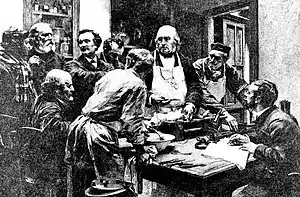Marie Françoise "Fanny" Bernard | |
|---|---|
| Born | Marie Françoise Martin |
| Nationality | French |
| Known for | Anti-vivisection campaigner |
| Spouse | Claude Bernard |
| Children | Two daughters, Jeanne-Henriette and Marie-Claude, and a son who died in infancy |
Marie Françoise "Fanny" Bernard (née Martin) (16 September 1819 – 9 October 1901) was the wife of the pioneer in experimental research in physiology, Claude Bernard.[1] She was shocked by his use of vivisection, and created an anti-vivisection society.
Background

Marie Françoise Martin married Claude Bernard on Wednesday 7 May 1845, and it was her dowry from her father, a physician, that allowed him to pursue his studies under François Magendie at the Collège de France in Paris.[2] They had three children—Jeanne-Henriette, Marie-Claude, and a son who died in infancy.[3]
Marie Françoise became opposed to her husband's research methods. Magendie, Claude Bernard and his fellow physiologists—men such as Charles Richet in France and Michael Foster in England—were strongly criticized for the vivisection they carried out on animals, particularly dogs. Anti-vivisectionists infiltrated Magendie's lectures in Paris, where he was dissecting dogs without anaesthetic, allegedly shouting "Tais-toi, pauvre bête!" ("Shut up, you poor beast!") while he worked on them.[4]
She separated from Bernard in 1870.[5]
Arthur de Bretagne
At the age of 19 Claude Bernard wrote a play called Arthur de Bretagne,[6] which was published only after his death.[7] Marie Françoise and her daughters alleged that it contained a preface that defamed them. They are thought to have sued to have the copies of the play destroyed. However, there was a radio production in 1936, and a second edition appeared in 1943.[6][8]
Experimental Animals: A Reality Fiction
In 2016, the American author of experimental literature Thalia Field published Experimental Animals: A Reality Fiction, a thoroughly-researched novel in which she writes about Claude Bernard and the nineteenth-century animal rights movement from the point of view of Marie-Françoise "Fanny" Bernard.
See also
Notes
- ↑ http://marduel.com/dossiers/claude-bernard.pdf, p.32
- ↑ Wolf, Stewart. "Introduction to the Transaction Edition," in Bernard, Claude. Experimental Medicine. Transaction Publishers, 1999, p. vii.
- ↑ "Claude, Bernard," in Oakes, Elizabeth. Encyclopedia of World Scientists. Volume 1, Infobase Publishing, 2007, p. 57.
- ↑ Gratzer, Walter. Eurekas and Euphorias: The Oxford Book of Scientific Anecdotes. Oxford University Press, 2004, p. 224.
- ↑ Rudacille, Deborah (2000). The Scalpel and the Butterfly. University of California Press. p. 19. ISBN 9780520231542.
- 1 2 "Claude Bernard" (PDF). Retrieved 25 April 2021.
- ↑ Bernard, Claude (1887). Arthur de Bretagne. Paris: E. Dentu.
- ↑ Bernard, Claude (1943). Arthur de Bretagne (2nd ed.). Paris: J.-M. Le Goff.